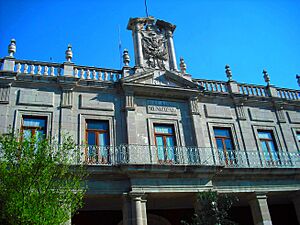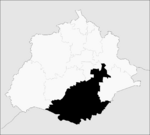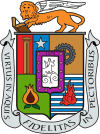Aguascalientes Municipality facts for kids
Quick facts for kids
Aguascalientes
|
||
|---|---|---|
|
Municipality
|
||

Aguascalientes City Hall
|
||
|
||
| Motto(s):
Virtus in Aquis, Fidelitas in Pectoribus
|
||

Location of Aguascalientes in Aguascalientes.
|
||
| Country | Mexico | |
| State | Aguascalientes | |
| Municipal seat | Aguascalientes | |
| Largest city | Aguascalientes | |
| Area | ||
| • Total | 1,178.85 km2 (455.16 sq mi) | |
| Population
(2010)
|
||
| • Total | 797,010 | |
| • Density | 676.091/km2 (1,751.068/sq mi) | |
| Data source: INEGI | ||
| Time zone | UTC-6 (CST) | |
| • Summer (DST) | UTC-5 (CDT) | |
| INEGI code | 001 | |
| Website | Municipio Virtual de Aguascalientes | |
| Source: Enciclopedia de los Municipios de México | ||
Aguascalientes is a special place in Mexico! It's both a state and a municipality, which is like a county. The main city, also called Aguascalientes, is the capital of the state. In 2010, about 797,010 people lived here. Most of them lived in the big city of Aguascalientes.
Where is Aguascalientes?
Aguascalientes is located in the southern part of a valley. This valley actually divides the state into two parts. The municipality shares its borders with several other municipalities in the state. These include El Llano, Jesús María, and Calvillo. It also borders the state of Jalisco to the south. The total area of the Aguascalientes municipality is about 1,169 square kilometers.
Who Lives in Aguascalientes?
In 2010, the Aguascalientes municipality had a total population of 797,010 people. The city of Aguascalientes itself was home to 722,250 of these people.
Besides the main city, there are many smaller towns and communities. Some of the larger ones include:
- Pocitos (with 5,169 people in 2010)
- Villa Licenciado Jesús Terán (Calvillito) (4,481 people)
- Norias de Ojocaliente (3,741 people)
- Norias del Paso Hondo (2,539 people)
These numbers show that most people in the municipality live in the main city. However, many also live in the smaller, charming towns nearby.
See Also
 In Spanish: Municipio de Aguascalientes para niños
In Spanish: Municipio de Aguascalientes para niños


